Analysis of Human Capital Management for Entrepreneurial Ventures
VerifiedAdded on 2022/08/25
|10
|2616
|17
Report
AI Summary
This report delves into the critical aspects of human capital management within an entrepreneurial context, emphasizing the importance of strategic human resource development for achieving business goals. It analyzes the alignment of HR practices with organizational objectives, exploring talent acquisition, retention, and development strategies. The report examines the challenges faced by organizations in resource allocation for employee retention and development, highlighting the significance of succession planning and career development. Furthermore, it underscores the need for flexible change management and the integration of human resource development as a core function. The report draws upon various articles to support its arguments, concluding that effective human capital management is essential for entrepreneurial success, particularly in the service sector, where employee needs must align with organizational goals. The report also includes a self-assessment component and references to support the analysis.
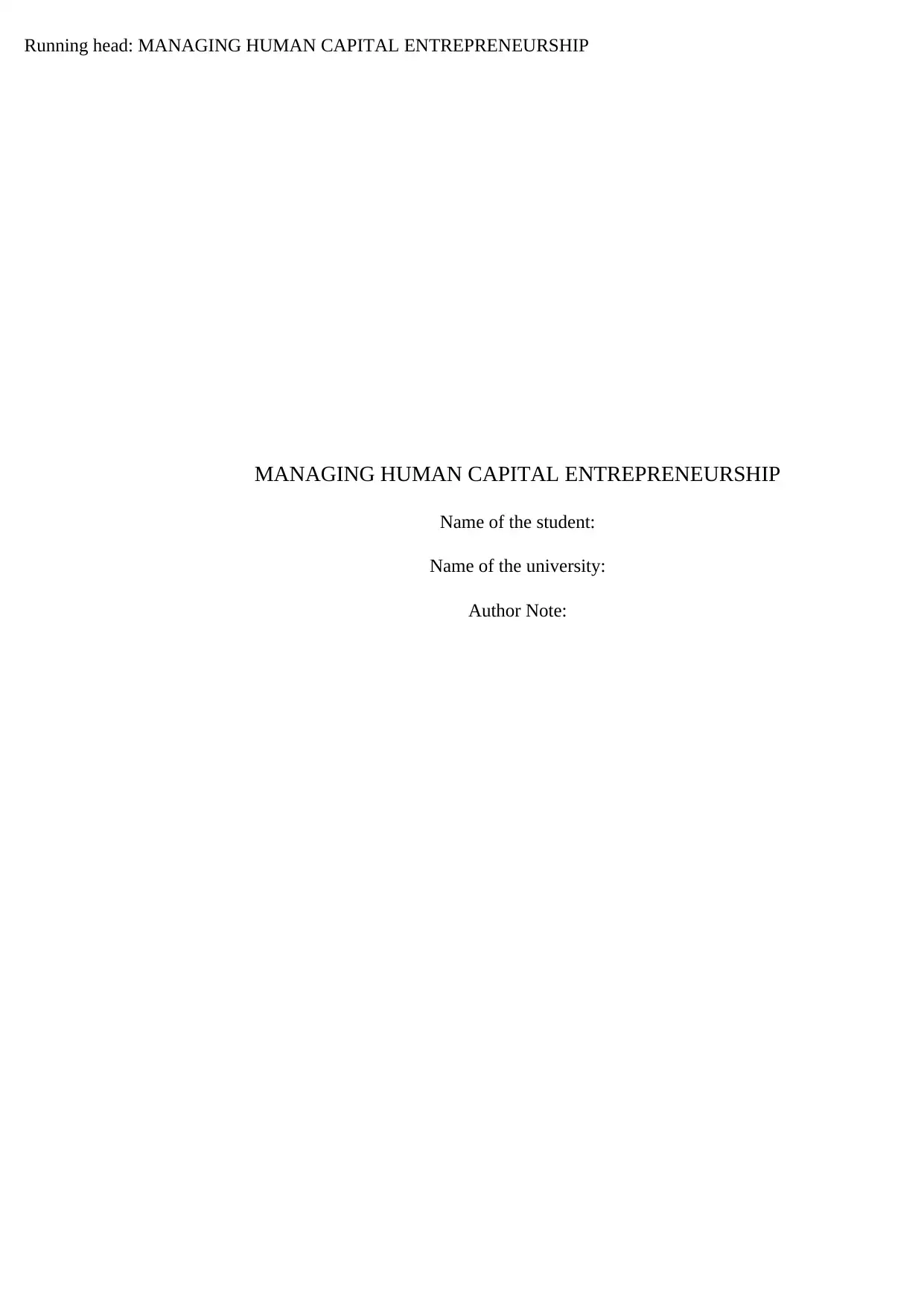
Running head: MANAGING HUMAN CAPITAL ENTREPRENEURSHIP
MANAGING HUMAN CAPITAL ENTREPRENEURSHIP
Name of the student:
Name of the university:
Author Note:
MANAGING HUMAN CAPITAL ENTREPRENEURSHIP
Name of the student:
Name of the university:
Author Note:
Paraphrase This Document
Need a fresh take? Get an instant paraphrase of this document with our AI Paraphraser

1MANAGING HUMAN CAPITAL ENTREPRENEURSHIP
Introduction
The human capital being an important issue for consideration for the talent
management in terms of recruitment, development and retention in a company. The human
capital management is more than recruiting and filing the vacancies. Employees, being the
highest value assets in an organizations needs proper human resource development and career
development within the job role they are performing.
Human capital management is the taking care of the human resources available in
the organization through strategies in order to nurture the best talent and retain them. Talent
management is the overall process of talent acquisition to talent retention, which is a sub-part
of the human capital management. Human resource development is a vast field where the
talent of the organization are to be looked after especially in their training needs and making
them more competent enough in the future. The human capital management and talent
management are the components of the strategic human resource development. Strategic
Human Resource Development is the area of framing of policies to setting strategic goals in
order to enhance the employee development is integrated within the external and internal
business environment.
The first article source discusses about the alignment of the strategic human resource
development in the organization to function as a whole. It talks about the key role of senior
line managers in the execution of the human resource development. The second article
source discusses about the deficiency of the human resource strategies in retention and
development with more focus provided on the recruitment and selection to fill gaps. The
third article focuses on the importance and integration of various departments in the
company to incorporate human resource development as the main crux of the organization. It
also discusses the process of building capability among the talented employees with the
proper availability of employee development elements in the proposed model referred.
Human resource development is a very vital area to stress on for the proper human
capital management. The retention of employees and developing the high-potential assets of
the organization is the main priority to avoid employee turnover. This area is often neglected
with the shifted focus on talent management with a narrower vision of replacement and filling
of vacant positions in the company. In order to keep the organization competitive in the
marketplace, there is a need for integration of human resource development strategies to be
set with respect to environment needs and challenges.
Introduction
The human capital being an important issue for consideration for the talent
management in terms of recruitment, development and retention in a company. The human
capital management is more than recruiting and filing the vacancies. Employees, being the
highest value assets in an organizations needs proper human resource development and career
development within the job role they are performing.
Human capital management is the taking care of the human resources available in
the organization through strategies in order to nurture the best talent and retain them. Talent
management is the overall process of talent acquisition to talent retention, which is a sub-part
of the human capital management. Human resource development is a vast field where the
talent of the organization are to be looked after especially in their training needs and making
them more competent enough in the future. The human capital management and talent
management are the components of the strategic human resource development. Strategic
Human Resource Development is the area of framing of policies to setting strategic goals in
order to enhance the employee development is integrated within the external and internal
business environment.
The first article source discusses about the alignment of the strategic human resource
development in the organization to function as a whole. It talks about the key role of senior
line managers in the execution of the human resource development. The second article
source discusses about the deficiency of the human resource strategies in retention and
development with more focus provided on the recruitment and selection to fill gaps. The
third article focuses on the importance and integration of various departments in the
company to incorporate human resource development as the main crux of the organization. It
also discusses the process of building capability among the talented employees with the
proper availability of employee development elements in the proposed model referred.
Human resource development is a very vital area to stress on for the proper human
capital management. The retention of employees and developing the high-potential assets of
the organization is the main priority to avoid employee turnover. This area is often neglected
with the shifted focus on talent management with a narrower vision of replacement and filling
of vacant positions in the company. In order to keep the organization competitive in the
marketplace, there is a need for integration of human resource development strategies to be
set with respect to environment needs and challenges.
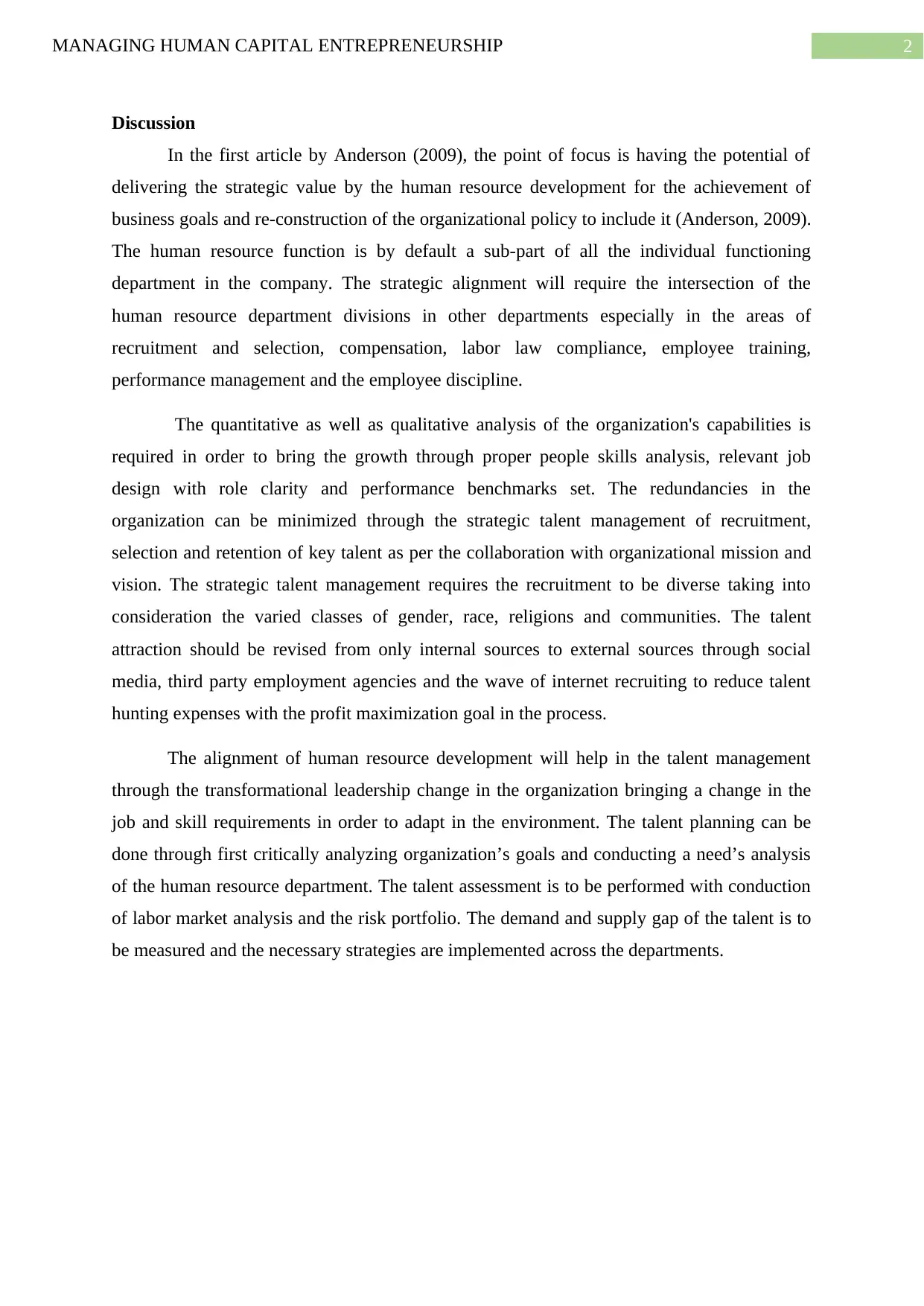
2MANAGING HUMAN CAPITAL ENTREPRENEURSHIP
Discussion
In the first article by Anderson (2009), the point of focus is having the potential of
delivering the strategic value by the human resource development for the achievement of
business goals and re-construction of the organizational policy to include it (Anderson, 2009).
The human resource function is by default a sub-part of all the individual functioning
department in the company. The strategic alignment will require the intersection of the
human resource department divisions in other departments especially in the areas of
recruitment and selection, compensation, labor law compliance, employee training,
performance management and the employee discipline.
The quantitative as well as qualitative analysis of the organization's capabilities is
required in order to bring the growth through proper people skills analysis, relevant job
design with role clarity and performance benchmarks set. The redundancies in the
organization can be minimized through the strategic talent management of recruitment,
selection and retention of key talent as per the collaboration with organizational mission and
vision. The strategic talent management requires the recruitment to be diverse taking into
consideration the varied classes of gender, race, religions and communities. The talent
attraction should be revised from only internal sources to external sources through social
media, third party employment agencies and the wave of internet recruiting to reduce talent
hunting expenses with the profit maximization goal in the process.
The alignment of human resource development will help in the talent management
through the transformational leadership change in the organization bringing a change in the
job and skill requirements in order to adapt in the environment. The talent planning can be
done through first critically analyzing organization’s goals and conducting a need’s analysis
of the human resource department. The talent assessment is to be performed with conduction
of labor market analysis and the risk portfolio. The demand and supply gap of the talent is to
be measured and the necessary strategies are implemented across the departments.
Discussion
In the first article by Anderson (2009), the point of focus is having the potential of
delivering the strategic value by the human resource development for the achievement of
business goals and re-construction of the organizational policy to include it (Anderson, 2009).
The human resource function is by default a sub-part of all the individual functioning
department in the company. The strategic alignment will require the intersection of the
human resource department divisions in other departments especially in the areas of
recruitment and selection, compensation, labor law compliance, employee training,
performance management and the employee discipline.
The quantitative as well as qualitative analysis of the organization's capabilities is
required in order to bring the growth through proper people skills analysis, relevant job
design with role clarity and performance benchmarks set. The redundancies in the
organization can be minimized through the strategic talent management of recruitment,
selection and retention of key talent as per the collaboration with organizational mission and
vision. The strategic talent management requires the recruitment to be diverse taking into
consideration the varied classes of gender, race, religions and communities. The talent
attraction should be revised from only internal sources to external sources through social
media, third party employment agencies and the wave of internet recruiting to reduce talent
hunting expenses with the profit maximization goal in the process.
The alignment of human resource development will help in the talent management
through the transformational leadership change in the organization bringing a change in the
job and skill requirements in order to adapt in the environment. The talent planning can be
done through first critically analyzing organization’s goals and conducting a need’s analysis
of the human resource department. The talent assessment is to be performed with conduction
of labor market analysis and the risk portfolio. The demand and supply gap of the talent is to
be measured and the necessary strategies are implemented across the departments.
⊘ This is a preview!⊘
Do you want full access?
Subscribe today to unlock all pages.

Trusted by 1+ million students worldwide
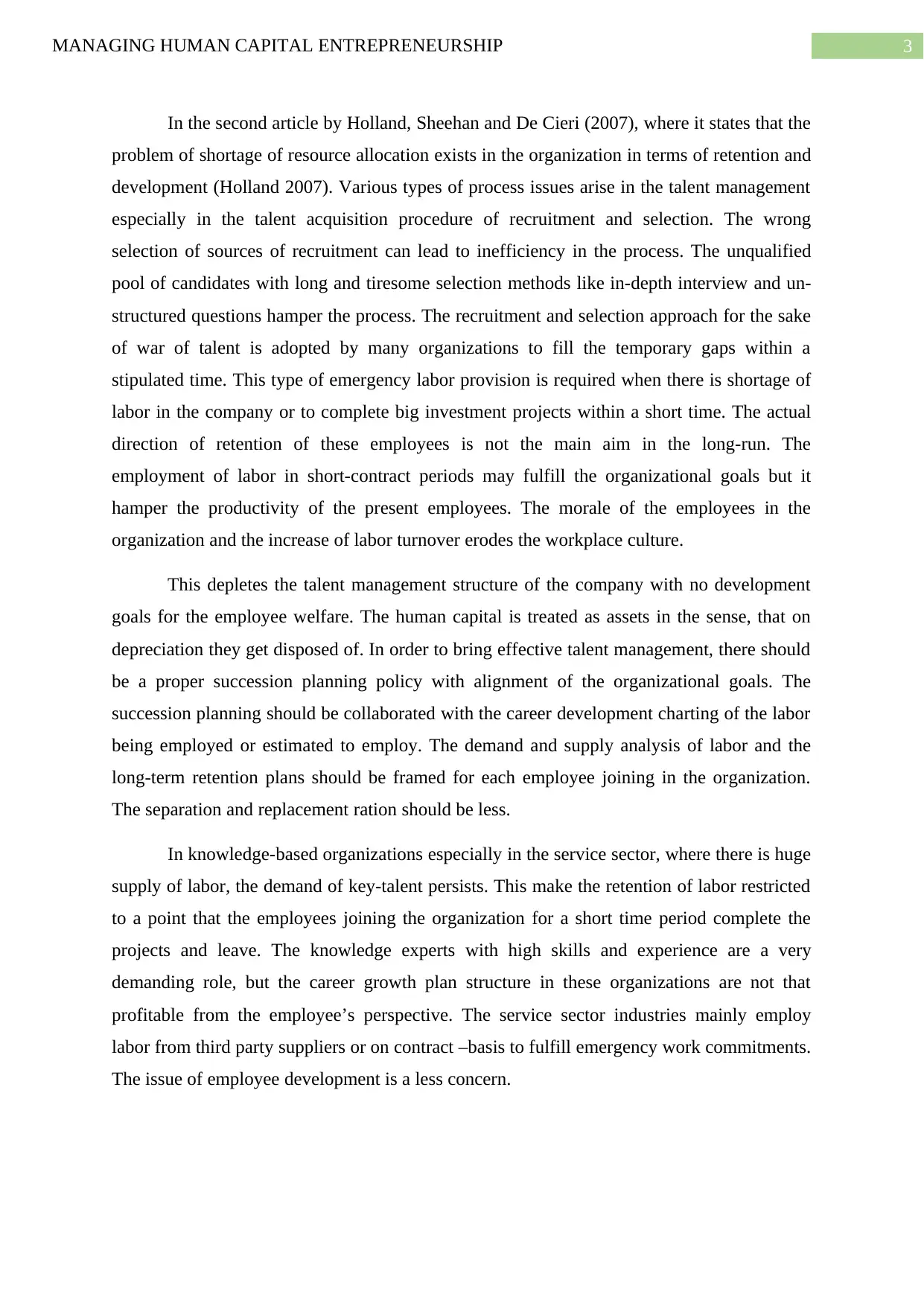
3MANAGING HUMAN CAPITAL ENTREPRENEURSHIP
In the second article by Holland, Sheehan and De Cieri (2007), where it states that the
problem of shortage of resource allocation exists in the organization in terms of retention and
development (Holland 2007). Various types of process issues arise in the talent management
especially in the talent acquisition procedure of recruitment and selection. The wrong
selection of sources of recruitment can lead to inefficiency in the process. The unqualified
pool of candidates with long and tiresome selection methods like in-depth interview and un-
structured questions hamper the process. The recruitment and selection approach for the sake
of war of talent is adopted by many organizations to fill the temporary gaps within a
stipulated time. This type of emergency labor provision is required when there is shortage of
labor in the company or to complete big investment projects within a short time. The actual
direction of retention of these employees is not the main aim in the long-run. The
employment of labor in short-contract periods may fulfill the organizational goals but it
hamper the productivity of the present employees. The morale of the employees in the
organization and the increase of labor turnover erodes the workplace culture.
This depletes the talent management structure of the company with no development
goals for the employee welfare. The human capital is treated as assets in the sense, that on
depreciation they get disposed of. In order to bring effective talent management, there should
be a proper succession planning policy with alignment of the organizational goals. The
succession planning should be collaborated with the career development charting of the labor
being employed or estimated to employ. The demand and supply analysis of labor and the
long-term retention plans should be framed for each employee joining in the organization.
The separation and replacement ration should be less.
In knowledge-based organizations especially in the service sector, where there is huge
supply of labor, the demand of key-talent persists. This make the retention of labor restricted
to a point that the employees joining the organization for a short time period complete the
projects and leave. The knowledge experts with high skills and experience are a very
demanding role, but the career growth plan structure in these organizations are not that
profitable from the employee’s perspective. The service sector industries mainly employ
labor from third party suppliers or on contract –basis to fulfill emergency work commitments.
The issue of employee development is a less concern.
In the second article by Holland, Sheehan and De Cieri (2007), where it states that the
problem of shortage of resource allocation exists in the organization in terms of retention and
development (Holland 2007). Various types of process issues arise in the talent management
especially in the talent acquisition procedure of recruitment and selection. The wrong
selection of sources of recruitment can lead to inefficiency in the process. The unqualified
pool of candidates with long and tiresome selection methods like in-depth interview and un-
structured questions hamper the process. The recruitment and selection approach for the sake
of war of talent is adopted by many organizations to fill the temporary gaps within a
stipulated time. This type of emergency labor provision is required when there is shortage of
labor in the company or to complete big investment projects within a short time. The actual
direction of retention of these employees is not the main aim in the long-run. The
employment of labor in short-contract periods may fulfill the organizational goals but it
hamper the productivity of the present employees. The morale of the employees in the
organization and the increase of labor turnover erodes the workplace culture.
This depletes the talent management structure of the company with no development
goals for the employee welfare. The human capital is treated as assets in the sense, that on
depreciation they get disposed of. In order to bring effective talent management, there should
be a proper succession planning policy with alignment of the organizational goals. The
succession planning should be collaborated with the career development charting of the labor
being employed or estimated to employ. The demand and supply analysis of labor and the
long-term retention plans should be framed for each employee joining in the organization.
The separation and replacement ration should be less.
In knowledge-based organizations especially in the service sector, where there is huge
supply of labor, the demand of key-talent persists. This make the retention of labor restricted
to a point that the employees joining the organization for a short time period complete the
projects and leave. The knowledge experts with high skills and experience are a very
demanding role, but the career growth plan structure in these organizations are not that
profitable from the employee’s perspective. The service sector industries mainly employ
labor from third party suppliers or on contract –basis to fulfill emergency work commitments.
The issue of employee development is a less concern.
Paraphrase This Document
Need a fresh take? Get an instant paraphrase of this document with our AI Paraphraser

4MANAGING HUMAN CAPITAL ENTREPRENEURSHIP
In the third article by Mitsakis (2019), it states that the static business environment
restrict the human resource development and the long-term vision goals fulfilment (Mitsakis
2018). The business environment in terms of political, economic, legal, social, technological
and environmental perspectives are changing. To adopt in such an environment, the flexible
approach to change management is required in the organization in order to bring effective
human resource development. The internal stakeholders be it the directors, shareholders,
employees , suppliers or the external stakeholders like customers and public should raise their
concerns for bringing the change management through a transformation in the business
operations. The human resource development should be the main axis of the organizational
functions. The employees need to be trained and be updated with all the relevant skills,
knowledge and abilities in order to bring productivity in the competitive environment. The
irresponsibleness of the organizational direction towards employee welfare will hamper the
growth in the long term.
The environmental integration in terms of horizontal, vertical, internal and external
factors can bring the strategic human resource development in an effective way through
transformational leadership. This type of leadership will require the managers and the
organizational top-board management to bring the change through implementation of various
current training programs in the departments. Joint-consultation meetings will be held where
the employees are to be made part in the decision-making process. The welfare of employees
are to be given first priority with re-design of discipline and compensation policies in the
organization. The horizontal and vertical change is to be brought through open
communication channels and the internal-external change is to be brought by aligning the
organizational strategies with the human development needs. The strategic partnerships with
certain human resource consultation bodies, training organizations will help in bringing the
human resource development interventions with better training framework within the budget
and the company’s output will grow. The top-management board is required to help in the
process through cooperation and minimizing the resistance from employees for such
development in such a flexible environment.
In the third article by Mitsakis (2019), it states that the static business environment
restrict the human resource development and the long-term vision goals fulfilment (Mitsakis
2018). The business environment in terms of political, economic, legal, social, technological
and environmental perspectives are changing. To adopt in such an environment, the flexible
approach to change management is required in the organization in order to bring effective
human resource development. The internal stakeholders be it the directors, shareholders,
employees , suppliers or the external stakeholders like customers and public should raise their
concerns for bringing the change management through a transformation in the business
operations. The human resource development should be the main axis of the organizational
functions. The employees need to be trained and be updated with all the relevant skills,
knowledge and abilities in order to bring productivity in the competitive environment. The
irresponsibleness of the organizational direction towards employee welfare will hamper the
growth in the long term.
The environmental integration in terms of horizontal, vertical, internal and external
factors can bring the strategic human resource development in an effective way through
transformational leadership. This type of leadership will require the managers and the
organizational top-board management to bring the change through implementation of various
current training programs in the departments. Joint-consultation meetings will be held where
the employees are to be made part in the decision-making process. The welfare of employees
are to be given first priority with re-design of discipline and compensation policies in the
organization. The horizontal and vertical change is to be brought through open
communication channels and the internal-external change is to be brought by aligning the
organizational strategies with the human development needs. The strategic partnerships with
certain human resource consultation bodies, training organizations will help in bringing the
human resource development interventions with better training framework within the budget
and the company’s output will grow. The top-management board is required to help in the
process through cooperation and minimizing the resistance from employees for such
development in such a flexible environment.
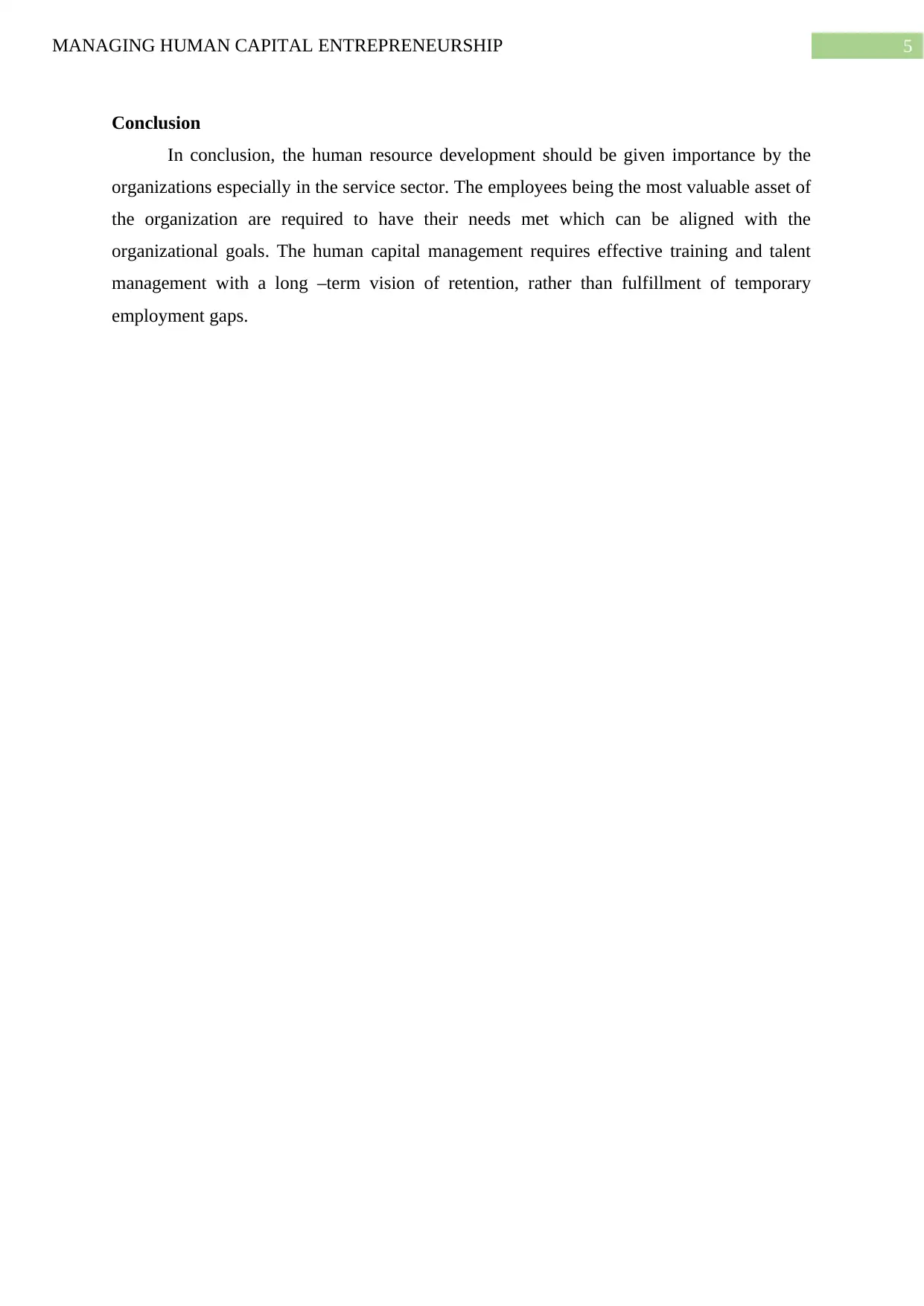
5MANAGING HUMAN CAPITAL ENTREPRENEURSHIP
Conclusion
In conclusion, the human resource development should be given importance by the
organizations especially in the service sector. The employees being the most valuable asset of
the organization are required to have their needs met which can be aligned with the
organizational goals. The human capital management requires effective training and talent
management with a long –term vision of retention, rather than fulfillment of temporary
employment gaps.
Conclusion
In conclusion, the human resource development should be given importance by the
organizations especially in the service sector. The employees being the most valuable asset of
the organization are required to have their needs met which can be aligned with the
organizational goals. The human capital management requires effective training and talent
management with a long –term vision of retention, rather than fulfillment of temporary
employment gaps.
⊘ This is a preview!⊘
Do you want full access?
Subscribe today to unlock all pages.

Trusted by 1+ million students worldwide
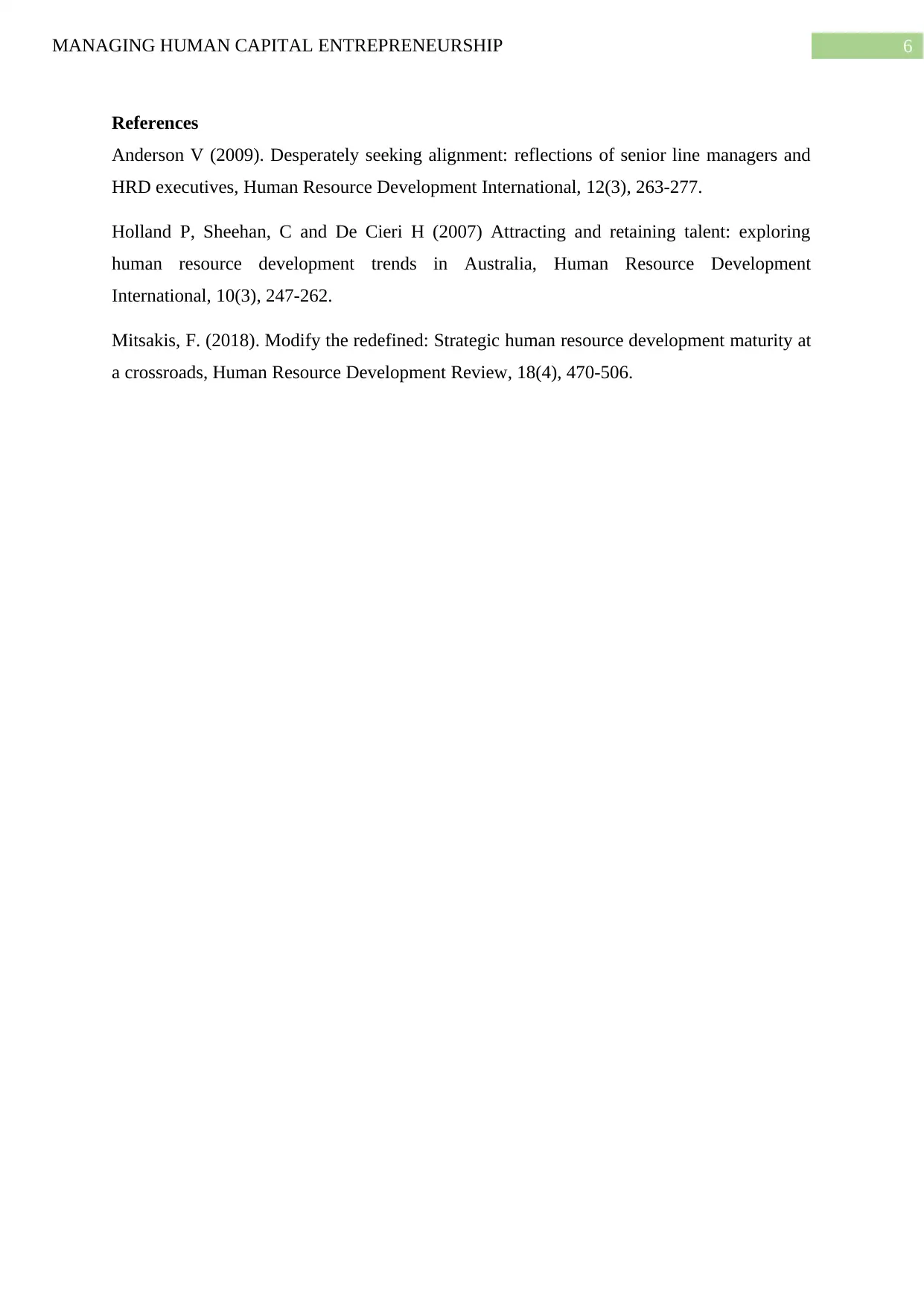
6MANAGING HUMAN CAPITAL ENTREPRENEURSHIP
References
Anderson V (2009). Desperately seeking alignment: reflections of senior line managers and
HRD executives, Human Resource Development International, 12(3), 263-277.
Holland P, Sheehan, C and De Cieri H (2007) Attracting and retaining talent: exploring
human resource development trends in Australia, Human Resource Development
International, 10(3), 247-262.
Mitsakis, F. (2018). Modify the redefined: Strategic human resource development maturity at
a crossroads, Human Resource Development Review, 18(4), 470-506.
References
Anderson V (2009). Desperately seeking alignment: reflections of senior line managers and
HRD executives, Human Resource Development International, 12(3), 263-277.
Holland P, Sheehan, C and De Cieri H (2007) Attracting and retaining talent: exploring
human resource development trends in Australia, Human Resource Development
International, 10(3), 247-262.
Mitsakis, F. (2018). Modify the redefined: Strategic human resource development maturity at
a crossroads, Human Resource Development Review, 18(4), 470-506.
Paraphrase This Document
Need a fresh take? Get an instant paraphrase of this document with our AI Paraphraser
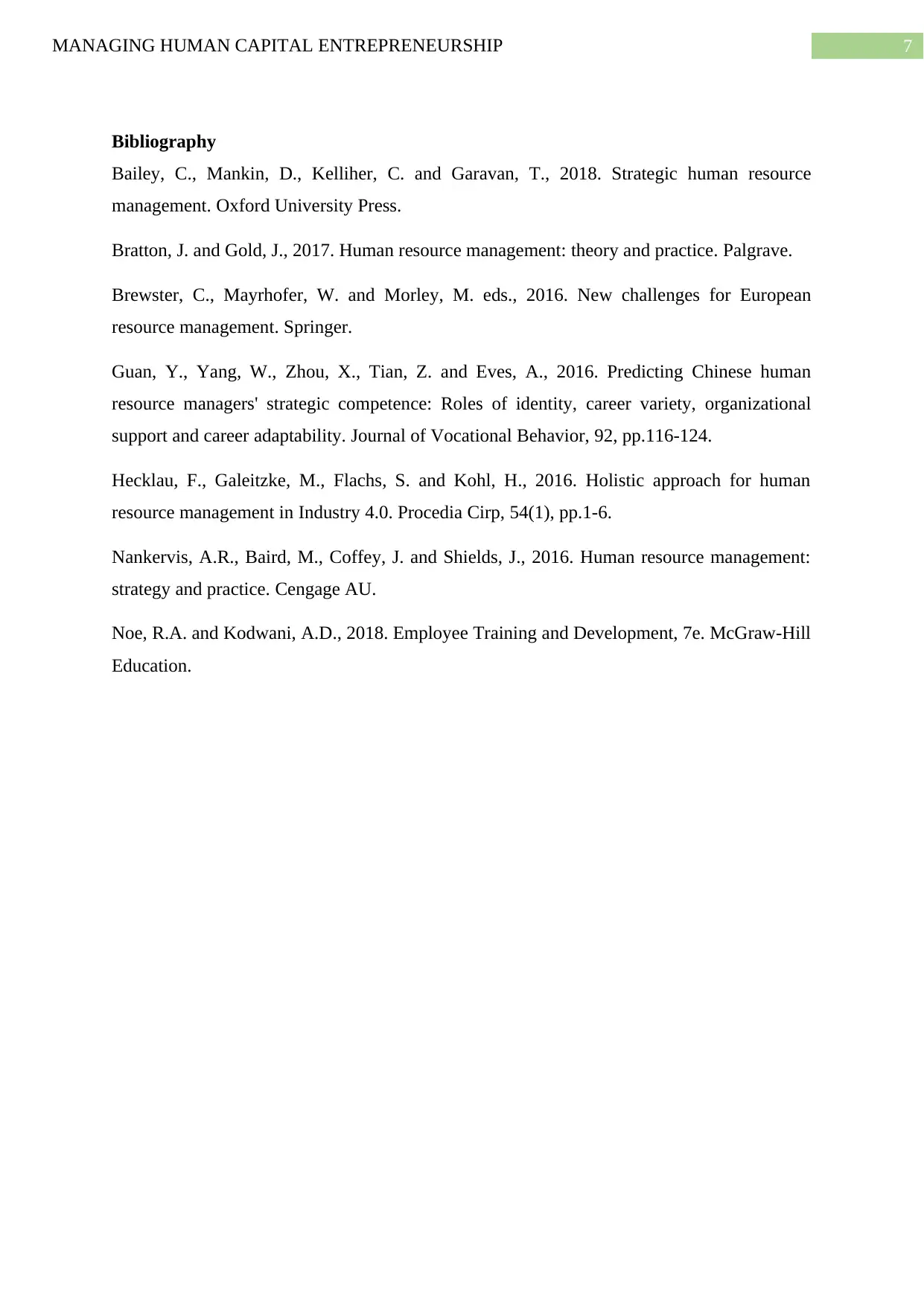
7MANAGING HUMAN CAPITAL ENTREPRENEURSHIP
Bibliography
Bailey, C., Mankin, D., Kelliher, C. and Garavan, T., 2018. Strategic human resource
management. Oxford University Press.
Bratton, J. and Gold, J., 2017. Human resource management: theory and practice. Palgrave.
Brewster, C., Mayrhofer, W. and Morley, M. eds., 2016. New challenges for European
resource management. Springer.
Guan, Y., Yang, W., Zhou, X., Tian, Z. and Eves, A., 2016. Predicting Chinese human
resource managers' strategic competence: Roles of identity, career variety, organizational
support and career adaptability. Journal of Vocational Behavior, 92, pp.116-124.
Hecklau, F., Galeitzke, M., Flachs, S. and Kohl, H., 2016. Holistic approach for human
resource management in Industry 4.0. Procedia Cirp, 54(1), pp.1-6.
Nankervis, A.R., Baird, M., Coffey, J. and Shields, J., 2016. Human resource management:
strategy and practice. Cengage AU.
Noe, R.A. and Kodwani, A.D., 2018. Employee Training and Development, 7e. McGraw-Hill
Education.
Bibliography
Bailey, C., Mankin, D., Kelliher, C. and Garavan, T., 2018. Strategic human resource
management. Oxford University Press.
Bratton, J. and Gold, J., 2017. Human resource management: theory and practice. Palgrave.
Brewster, C., Mayrhofer, W. and Morley, M. eds., 2016. New challenges for European
resource management. Springer.
Guan, Y., Yang, W., Zhou, X., Tian, Z. and Eves, A., 2016. Predicting Chinese human
resource managers' strategic competence: Roles of identity, career variety, organizational
support and career adaptability. Journal of Vocational Behavior, 92, pp.116-124.
Hecklau, F., Galeitzke, M., Flachs, S. and Kohl, H., 2016. Holistic approach for human
resource management in Industry 4.0. Procedia Cirp, 54(1), pp.1-6.
Nankervis, A.R., Baird, M., Coffey, J. and Shields, J., 2016. Human resource management:
strategy and practice. Cengage AU.
Noe, R.A. and Kodwani, A.D., 2018. Employee Training and Development, 7e. McGraw-Hill
Education.
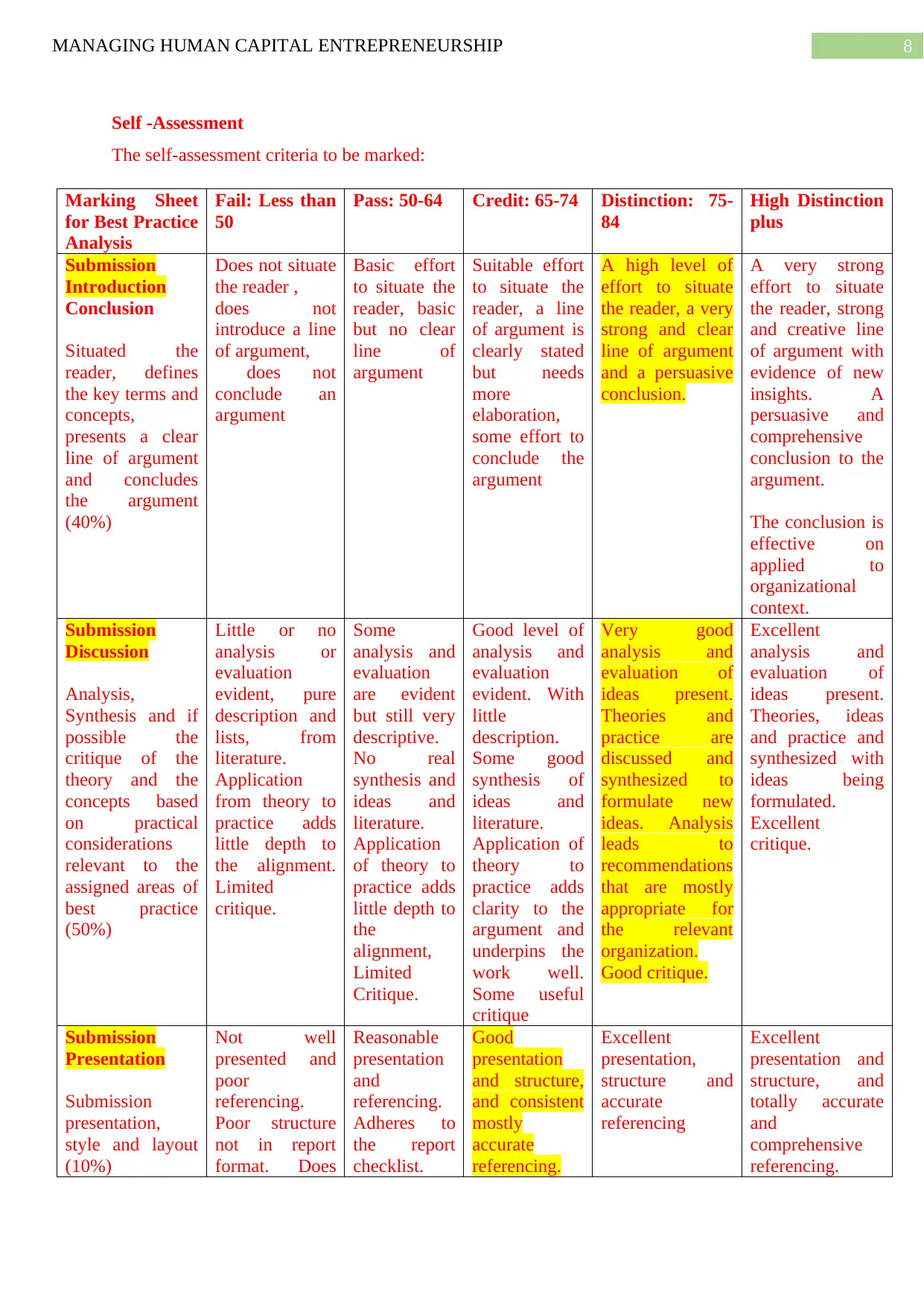
8MANAGING HUMAN CAPITAL ENTREPRENEURSHIP
Self -Assessment
The self-assessment criteria to be marked:
Marking Sheet
for Best Practice
Analysis
Fail: Less than
50
Pass: 50-64 Credit: 65-74 Distinction: 75-
84
High Distinction
plus
Submission
Introduction
Conclusion
Situated the
reader, defines
the key terms and
concepts,
presents a clear
line of argument
and concludes
the argument
(40%)
Does not situate
the reader ,
does not
introduce a line
of argument,
does not
conclude an
argument
Basic effort
to situate the
reader, basic
but no clear
line of
argument
Suitable effort
to situate the
reader, a line
of argument is
clearly stated
but needs
more
elaboration,
some effort to
conclude the
argument
A high level of
effort to situate
the reader, a very
strong and clear
line of argument
and a persuasive
conclusion.
A very strong
effort to situate
the reader, strong
and creative line
of argument with
evidence of new
insights. A
persuasive and
comprehensive
conclusion to the
argument.
The conclusion is
effective on
applied to
organizational
context.
Submission
Discussion
Analysis,
Synthesis and if
possible the
critique of the
theory and the
concepts based
on practical
considerations
relevant to the
assigned areas of
best practice
(50%)
Little or no
analysis or
evaluation
evident, pure
description and
lists, from
literature.
Application
from theory to
practice adds
little depth to
the alignment.
Limited
critique.
Some
analysis and
evaluation
are evident
but still very
descriptive.
No real
synthesis and
ideas and
literature.
Application
of theory to
practice adds
little depth to
the
alignment,
Limited
Critique.
Good level of
analysis and
evaluation
evident. With
little
description.
Some good
synthesis of
ideas and
literature.
Application of
theory to
practice adds
clarity to the
argument and
underpins the
work well.
Some useful
critique
Very good
analysis and
evaluation of
ideas present.
Theories and
practice are
discussed and
synthesized to
formulate new
ideas. Analysis
leads to
recommendations
that are mostly
appropriate for
the relevant
organization.
Good critique.
Excellent
analysis and
evaluation of
ideas present.
Theories, ideas
and practice and
synthesized with
ideas being
formulated.
Excellent
critique.
Submission
Presentation
Submission
presentation,
style and layout
(10%)
Not well
presented and
poor
referencing.
Poor structure
not in report
format. Does
Reasonable
presentation
and
referencing.
Adheres to
the report
checklist.
Good
presentation
and structure,
and consistent
mostly
accurate
referencing.
Excellent
presentation,
structure and
accurate
referencing
Excellent
presentation and
structure, and
totally accurate
and
comprehensive
referencing.
Self -Assessment
The self-assessment criteria to be marked:
Marking Sheet
for Best Practice
Analysis
Fail: Less than
50
Pass: 50-64 Credit: 65-74 Distinction: 75-
84
High Distinction
plus
Submission
Introduction
Conclusion
Situated the
reader, defines
the key terms and
concepts,
presents a clear
line of argument
and concludes
the argument
(40%)
Does not situate
the reader ,
does not
introduce a line
of argument,
does not
conclude an
argument
Basic effort
to situate the
reader, basic
but no clear
line of
argument
Suitable effort
to situate the
reader, a line
of argument is
clearly stated
but needs
more
elaboration,
some effort to
conclude the
argument
A high level of
effort to situate
the reader, a very
strong and clear
line of argument
and a persuasive
conclusion.
A very strong
effort to situate
the reader, strong
and creative line
of argument with
evidence of new
insights. A
persuasive and
comprehensive
conclusion to the
argument.
The conclusion is
effective on
applied to
organizational
context.
Submission
Discussion
Analysis,
Synthesis and if
possible the
critique of the
theory and the
concepts based
on practical
considerations
relevant to the
assigned areas of
best practice
(50%)
Little or no
analysis or
evaluation
evident, pure
description and
lists, from
literature.
Application
from theory to
practice adds
little depth to
the alignment.
Limited
critique.
Some
analysis and
evaluation
are evident
but still very
descriptive.
No real
synthesis and
ideas and
literature.
Application
of theory to
practice adds
little depth to
the
alignment,
Limited
Critique.
Good level of
analysis and
evaluation
evident. With
little
description.
Some good
synthesis of
ideas and
literature.
Application of
theory to
practice adds
clarity to the
argument and
underpins the
work well.
Some useful
critique
Very good
analysis and
evaluation of
ideas present.
Theories and
practice are
discussed and
synthesized to
formulate new
ideas. Analysis
leads to
recommendations
that are mostly
appropriate for
the relevant
organization.
Good critique.
Excellent
analysis and
evaluation of
ideas present.
Theories, ideas
and practice and
synthesized with
ideas being
formulated.
Excellent
critique.
Submission
Presentation
Submission
presentation,
style and layout
(10%)
Not well
presented and
poor
referencing.
Poor structure
not in report
format. Does
Reasonable
presentation
and
referencing.
Adheres to
the report
checklist.
Good
presentation
and structure,
and consistent
mostly
accurate
referencing.
Excellent
presentation,
structure and
accurate
referencing
Excellent
presentation and
structure, and
totally accurate
and
comprehensive
referencing.
⊘ This is a preview!⊘
Do you want full access?
Subscribe today to unlock all pages.

Trusted by 1+ million students worldwide
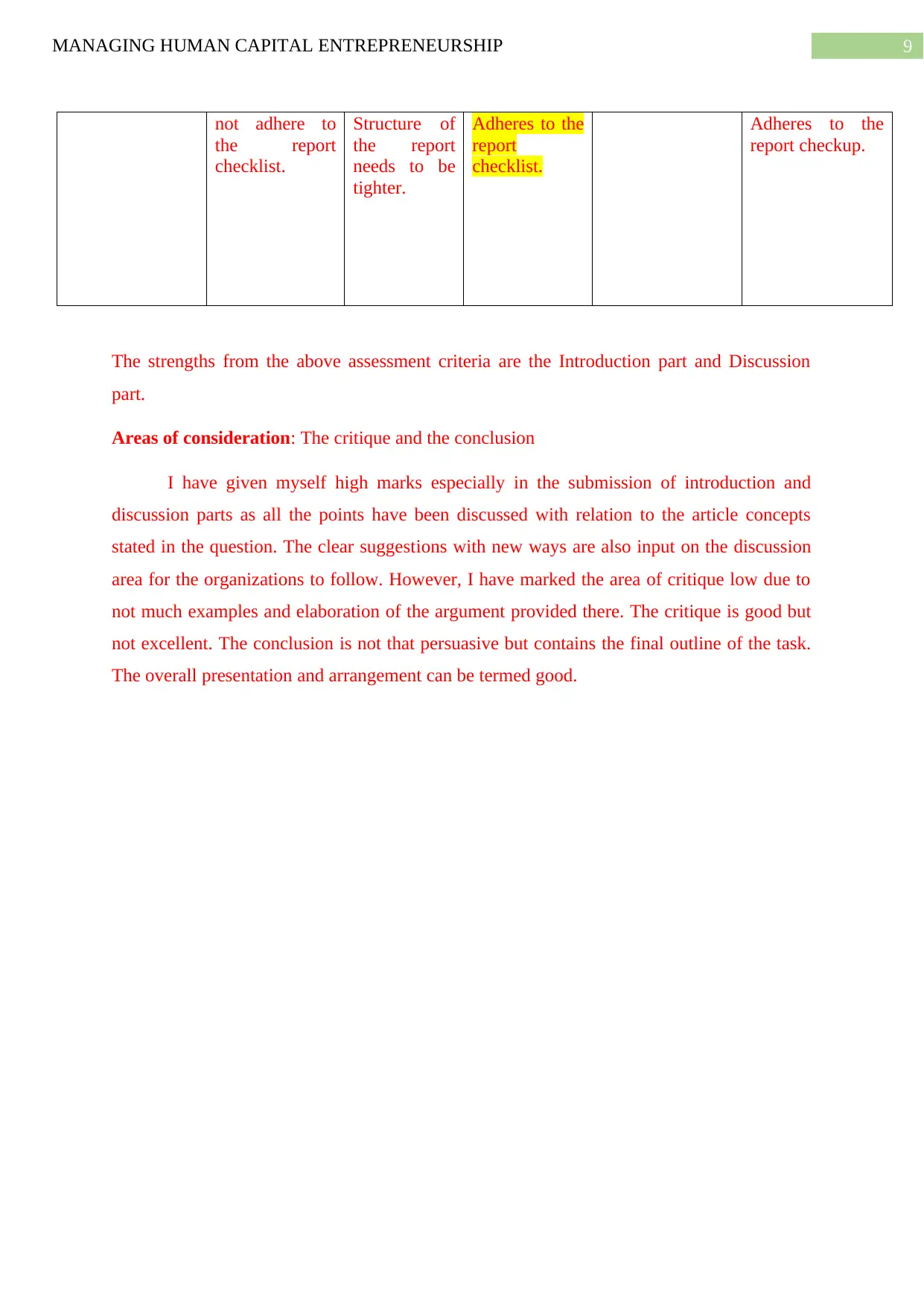
9MANAGING HUMAN CAPITAL ENTREPRENEURSHIP
not adhere to
the report
checklist.
Structure of
the report
needs to be
tighter.
Adheres to the
report
checklist.
Adheres to the
report checkup.
The strengths from the above assessment criteria are the Introduction part and Discussion
part.
Areas of consideration: The critique and the conclusion
I have given myself high marks especially in the submission of introduction and
discussion parts as all the points have been discussed with relation to the article concepts
stated in the question. The clear suggestions with new ways are also input on the discussion
area for the organizations to follow. However, I have marked the area of critique low due to
not much examples and elaboration of the argument provided there. The critique is good but
not excellent. The conclusion is not that persuasive but contains the final outline of the task.
The overall presentation and arrangement can be termed good.
not adhere to
the report
checklist.
Structure of
the report
needs to be
tighter.
Adheres to the
report
checklist.
Adheres to the
report checkup.
The strengths from the above assessment criteria are the Introduction part and Discussion
part.
Areas of consideration: The critique and the conclusion
I have given myself high marks especially in the submission of introduction and
discussion parts as all the points have been discussed with relation to the article concepts
stated in the question. The clear suggestions with new ways are also input on the discussion
area for the organizations to follow. However, I have marked the area of critique low due to
not much examples and elaboration of the argument provided there. The critique is good but
not excellent. The conclusion is not that persuasive but contains the final outline of the task.
The overall presentation and arrangement can be termed good.
1 out of 10
Related Documents
Your All-in-One AI-Powered Toolkit for Academic Success.
+13062052269
info@desklib.com
Available 24*7 on WhatsApp / Email
![[object Object]](/_next/static/media/star-bottom.7253800d.svg)
Unlock your academic potential
Copyright © 2020–2025 A2Z Services. All Rights Reserved. Developed and managed by ZUCOL.





